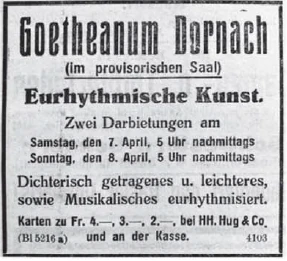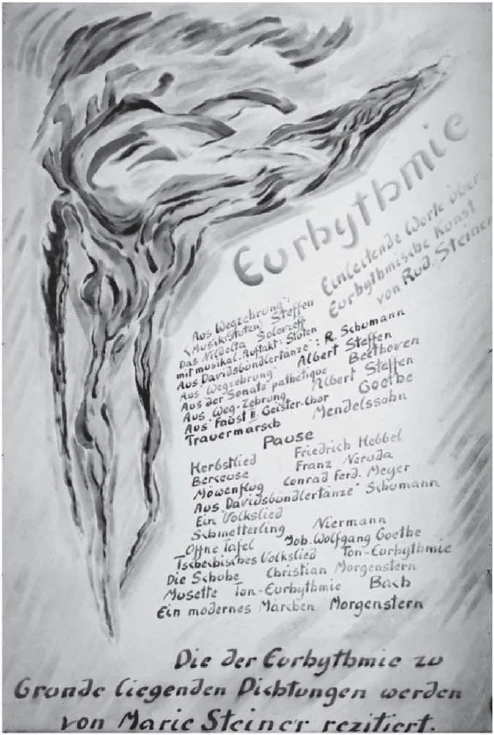The Origin and Development of Eurythmy
1923–1925
GA 277d
7 April 1923, Dornach
Translated by Steiner Online Library
Eurythmy Performance


Dear audience!
You will have heard these introductory words to our eurythmic performances many times before, so today I need only briefly mention that you are in for a very special treat: namely, if you are particularly interested in this eurythmic art, you will have the opportunity today to get to know it from two sides, so to speak. In the first part of the program, you will see accomplished eurythmists, so to speak, and in the second part of the program, you will see eurythmists who are still developing.
So you will see what you are used to seeing, the developed eurythmists, and after the break you will be able to see the eurythmists who are still developing. In the first part of the program, you will be able to see how the eurythmic form of expression has already become art, how the form has already matured into art. Then there will be an intermission, and then those who have only recently learned eurythmy will perform. You will then be able to see the difference in a subtle way. Those who are struggling, those who are still developing, in whom you can still see how the movements are taking shape, striving to become art — you will see that in the second part.
So we can say: today you will have the opportunity to see how eurythmy becomes part of the human being itself — how the human being progresses from eurythmic speech to eurythmic artistic creation. However, for easily understandable reasons, we will show you the finished product before the break and the struggling process after the break.
Now, I must say that those who take eurythmy very seriously are particularly keen to gain such an insight into the development of eurythmic art, and that it therefore seems particularly justified for me to express my great pleasure at the large number of visitors here today.
Ansprache zur Eurythmie


Sehr verehrte Anwesende!
Sie werden schon öfters diese einleitenden Worte zu unseren eurythmischen Darbietungen gehört haben, sodass ich heute nur kurz vorauszusenden habe, dass Ihnen ein ganz besonderer Genuss heute bevorsteht: Dass Sie nämlich heute, wenn Sie sich für diese eurythmische Kunst ganz besonders interessieren, die Möglichkeit haben, diese eurythmische Kunst, ich möchte sagen zweiseitig kennenzulernen. Sie werden in der ersten Abteilung des Programmes gewissermaßen vollendete Eurythmisten sehen und in einem zweiten Teil des Programmes die sich entwickelnden Eurythmisten sehen können.
Also Sie sehen, was Sie sonst gewohnt zu sehen sind, die entwickelten Eurythmisten, und nach der Pause werden Sie in Augenschein nehmen können die erst sich entwickelnden Eurythmisten. Sie werden also sehen können im ersten Teil des Programms, wie da wirklich die eurythmische Ausdrucksform bereits Kunst geworden ist, also die Formung bereits zur Kunst sich gerundet hat. Dann wird die Pause kommen, und dann werden diejenigen auftreten, die erst in der letzten Zeit Eurythmie gelernt haben. Sie werden dann in einer feinen Weise den Unterschied konstatieren können. Die Ringenden, die Sich-Entwickelnden, bei denen man noch sieht, wie die Bewegungen in die Form hineingehen, erst in die Kunst hineinstreben — das werden Sie im zweiten Teil sehen.
So also kann man sagen: Sie werden heute die Gelegenheit finden zu sehen, wie Eurythmie wird am Menschen selber - wie der Mensch aus dem eurythmischen Sprechen zu dem eurythmischen künstlerischen Gestalten vordringt. Allerdings aus leicht begreiflichen Gründen haben wir Ihnen vor der Pause das Vollendete und nach der Pause das Ringende zur Darstellung zu bringen.
Nun, ich darf aber sagen, dass es ja denjenigen, die es mit der Eurythmie sehr ernst nehmen, ganz besonders auf dem Herzen liegt, dass man eine solche Anschauung von der Entwicklung der eurythmischen Kunst gewinnen kann, und dass daher es besonders gerechtfertigt erscheinen mag, wenn ich die ganz besondere Freude über den heute so zahlreichen Besuch zum Ausdruck bringe.

